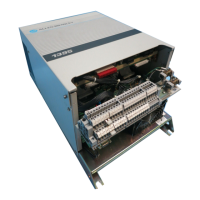Malfunctions with Indications 2-7
Bulletin 1300 Programming
Terminal
You can also use the Bulletin 1300 Programming Terminals to monitor the
terminal fault status of the 1395 drive. Any of the fault status parameters
(100, 101, 630) can be monitored through the Programming Terminal. Use
Main Menu item 3 “Parameter”.
In addition, when a Hard or Soft Fault occurs, the fault message will appear
immediately on the screen of the programming terminal. To view all of the
faults in the Fault Queue, select Main Menu item 7 “Faults”. Then select
Fault Menu Item 1 “View Faults” to view the last 16 faults that occurred.
Use the INC/DEC keys to move through the Fault Queue for that processor.
Use the ENTER key to view other processor’s fault queues if they exist. All
types of detectable faults that have occurred will be present in the Fault
Queue.
Any problems with the Programming Terminal itself will be evidenced by a
missing or non-active Pendulum on the initial display. If programming
terminal problems are suspected, refer to the terminal instruction manual.
Fault Descriptions and
Recovery
Each processor in the 1395 drive has unique fault detection and message
capabilities which it can generate. These fault diagnostics can consist of
Hard, Soft, or Warning type faults and can cause the drive to respond in
various ways. The faults detected by each processor are listed, along with a
complete description, possible causes and possible fault recovery
procedures that will allow the malfunction to be corrected.
A recurring fault, as referenced below in the Recovery procedure, refers to a
fault that repeats as soon as normal operation is attempted. Faults that
reoccur at random intervals may be due to a transient condition and not
necessarily a board or component malfunction.
Fault Display on HHT or DHT
System Processor Faults
(SP–XX)
In general most System Processor faults indicate that an internal processor
error somewhere in the 1395 system has occurred. These faults can be
induced by Electrostatic Discharge (ESD), Electro Magnetic Interference
(EMI), excessive heat, contamination of printed circuit boards (PCB),
connections that are damaged or do not seat properly, etc. An attempt
should be made to correct any of these environmental conditions prior to
replacing components in the drive. This should reduce the possibility of
reoccurrence. If board replacement is necessary, replace the complete
board, DO NOT reuse EPROM chips.
No. Name Description Recovery
10 Comm Fault Attempting to
re-establish
communication.
1. Drive may be held in a continual reset. If
Reset/Stop input TB3-3, is held high (24 or
115 volts applied). and parameter 620 = 0
(Default setting), Drive will be in a continual
reset. Set parameter 620 to a non zero value.
2. Check integrity of PE and TE ground. Check
for “Floating” TE, or ground loops
Aotewell Ltd industry-mall.net

